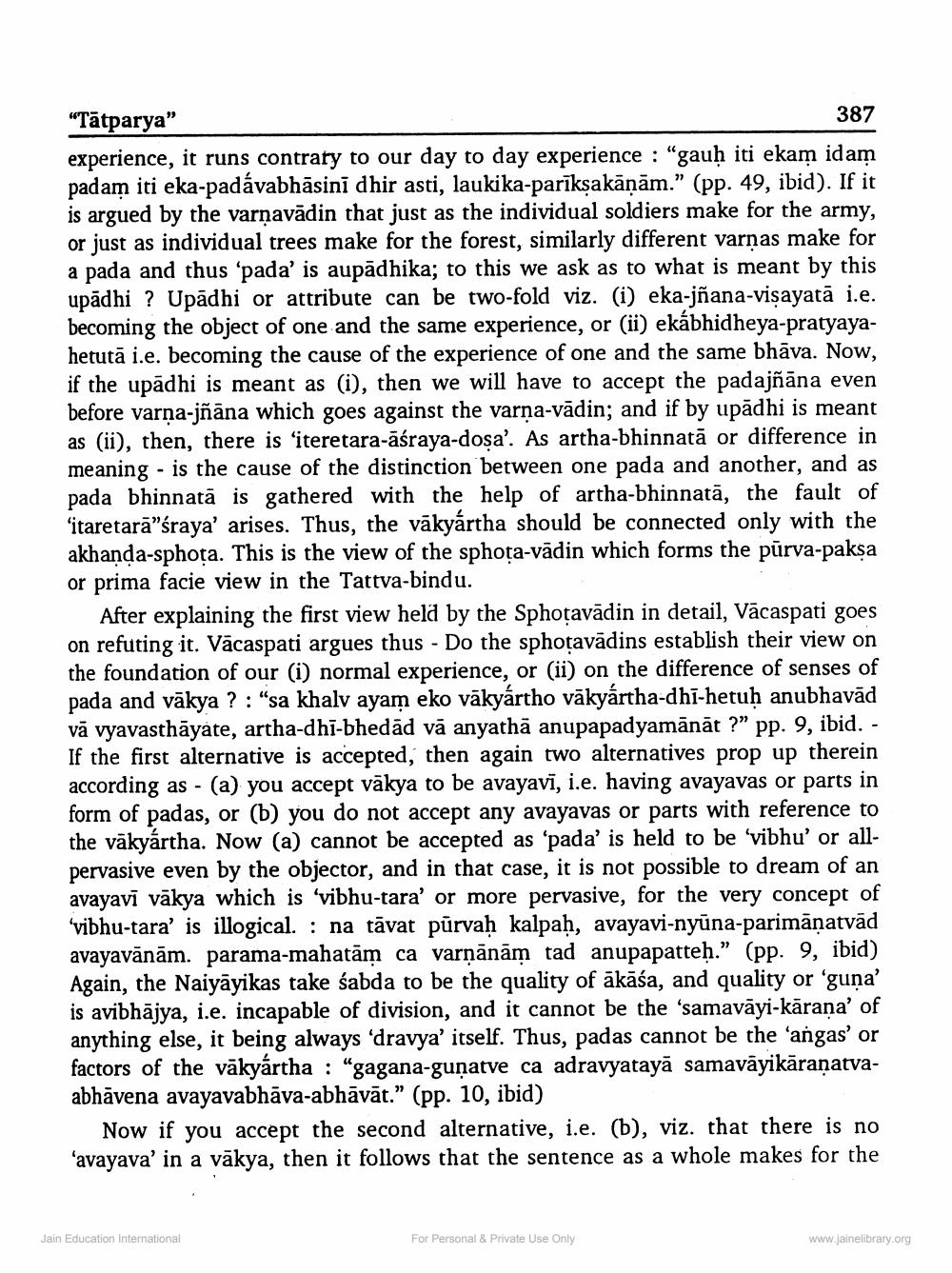________________
"Tātparya"
387 experience, it runs contrary to our day to day experience : "gauḥ iti ekam idam padam iti eka-padávabhāsini dhir asti, laukika-parīksakāņām.” (pp. 49, ibid). If it is argued by the varnavādin that just as the individual soldiers make for the army, or just as individual trees make for the forest, similarly different varnas make for a pada and thus 'pada' is aupādhika; to this we ask as to what is meant by this upādhi ? Upādhi or attribute can be two-fold viz. (i) eka-jñana-visayatā i.e. becoming the object of one and the same experience, or (ii) ekábhidheya-pratyaya hetutā i.e. becoming the cause of the experience of one and the same bhāva. Now, if the upādhi is meant as (i), then we will have to accept the padajñāna even before varna-jñāna which goes against the varna-vādin; and if by upādhi is meant as (ii), then, there is 'iteretara-āśraya-dosa'. As artha-bhinnatā or difference in meaning - is the cause of the distinction between one pada and another, and as pada bhinnatā is gathered with the help of artha-bhinnatā, the fault of 'itaretarā"śraya' arises. Thus, the vākyártha should be connected only with the akhanda-sphota. This is the view of the sphota-vādin which forms the pūrva-paksa or prima facie view in the Tattva-bindu.
After explaining the first view held by the Sphoțavādin in detail, Vācaspati goes on refuting it. Vācaspati argues thus - Do the sphotavādins establish their view on the foundation of our (i) normal experience, or (ii) on the difference of senses of pada and vākya ? : “sa khalv ayam eko vākyártho vākyártha-dhi-hetuh anubhavād vā vyavasthāyate, artha-dhi-bhedad vā anyathā anupapadyamānāt ?" pp. 9, ibid. - If the first alternative is accepted, then again two alternatives prop up therein
pt vākya to be avayavī, i.e. having avayavas or form of padas, or (b) you do not accept any avayavas or parts with reference to the vākyártha. Now (a) cannot be accepted as 'pada' is held to be 'vibhu' or allpervasive even by the objector, and in that case, it is not possible to dream of an avayavī vākya which is 'vibhu-tara' or more pervasive, for the very concept of 'vibhu-tara' is illogical. : na tāvat pūrvah kalpah, avayavi-nyūna-parimānatvad avayavānām. parama-mahatām ca varņānām tad anupapatteh.” (pp. 9, ibid) Again, the Naiyāyikas take sabda to be the quality of ākāśa, and quality or 'guna' is avibhājya, i.e. incapable of division, and it cannot be the 'samavāyi-kārana' of anything else, it being always 'dravya' itself. Thus, padas cannot be the 'angas' or factors of the vākyártha : "gagana-gunatve ca adravyatayā samavāyikāranatvaabhāvena avayavabhāva-abhāvāt.” (pp. 10, ibid)
Now if you accept the second alternative, i.e. (b), viz. that there is no 'avayava' in a vākya, then it follows that the sentence as a whole makes for the
Jain Education International
For Personal & Private Use Only
www.jainelibrary.org




